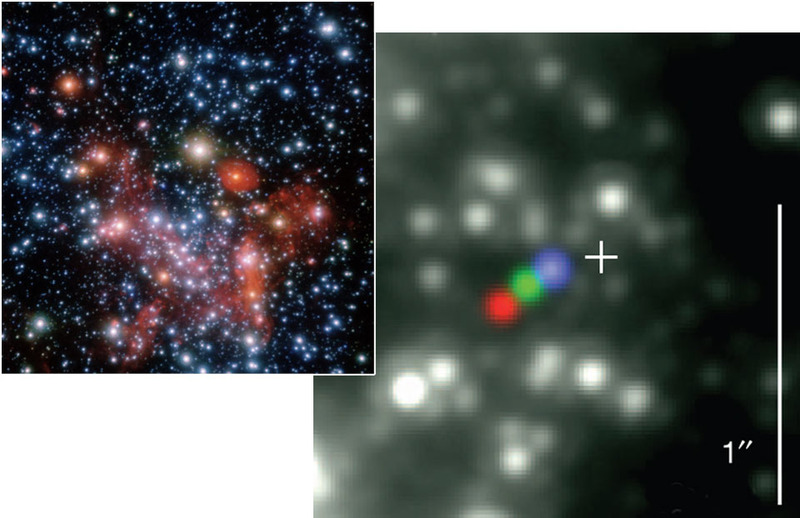







| BOOKS | F. A. Q. | ARTICLES | TALKS | ABOUT KEN | DONATE | BEYOND OUR KEN |
|---|
By Ken Croswell
Published on ScienceNOW (December 14, 2011)

Kamikaze cloud? The colored dots in the right-hand image show positions in 2004 (red), 2008 (green), and 2011 (blue) of what may be a cloud of gas and dust plummeting toward the Galaxy's central black hole, marked here by a cross. Left-hand image of the Galactic center from the European Southern Observatory; right-hand image adapted from Stefan Gillessen et al.
Every starship captain knows the true prime directive: steer clear of black holes. Well, it appears that one object didn't get the memo. According to a new study, a small cloud of gas and dust is racing toward the black hole at the center of the Milky Way--and when it hits, be prepared for some astronomical fireworks.
The black hole, named Sagittarius A*, weighs 4 million times as much as our Sun and is 27,000 light-years away. Every star in the Milky Way revolves around it. Our Sun takes 230 million years to complete an orbit, but one known star is so close that it revolves around Sagittarius A* in just 16 years.
Now astronomers have spotted a new object near the black hole. Stefan Gillessen and Reinhard Genzel of the Max Planck Institute for Extraterrestrial Physics in Garching, Germany, and their colleagues used the European Southern Observatory's Very Large Telescope in Chile to observe the Milky Way's center at infrared wavelengths, which penetrate the thick dust between it and us. The instrument picked up a small gas cloud that, over 9 years of observations, appeared to be getting closer and closer to Sagittarius A*. The astronomers detected the object at a wavelength of 3.76 microns but not at 2.16 microns. This indicates it is a cloud of gas and dust rather than a star, they say, because a star is so hot that it should be brighter at the shorter wavelength.
The cloud is about three times as massive as Earth, emits five times as much energy as the Sun, and spans 250 times the distance from the Earth to the Sun. Its temperature is about 550 Kelvin, or 530 degrees Fahrenheit--somewhat cooler than the surface of Venus. Sagittarius A*'s immense gravity is accelerating the cloud dramatically: in 2004, the cloud was hurtling toward the black hole at 1200 kilometers per second; by 2011, the speed had nearly doubled, reaching 2350 kilometers per second. At that velocity, an airplane could circle the Earth in 17 seconds.
The cloud will approach Sagittarius A* in the summer of 2013, when the center of the gas and dust will be 260 times as far from the black hole as Earth is from the Sun. But as the cloud hits hot gas already orbiting the black hole, it will likely meet its end. "It became really exciting when we noticed in the 2011 data that the cloud is starting to be stretched like spaghetti," Gillessen says. "So right in front of our eyes, we can see the black hole is destroying the cloud. The material will rain down into the black hole and release a tremendous amount of energy." As pieces of the cloud fall into Sagittarius A* over the next decade, friction and gravity will heat them to temperatures of millions of degrees, producing x-rays, the team reports online today in Nature. Other astronomers have detected "echos" of x-rays near the Galactic center--reflections of radiation that have lit up large clouds hundreds of light-years away and that likely arose when past clouds dove into the black hole and sparked outbursts of x-rays.
Astronomer Andrea Ghez of the University of California, Los Angeles, who has seen the same object in her data, wouldn't bet her house on such drama unfolding, however. "A much more likely interpretation is that this is a star that has an infrared excess," she says, noting that dust surrounding a star can absorb visible light and reemit it at infrared wavelengths. If the object is merely a star, then it won't fall into the black hole but will shoot past it as the star loops around Sagittarius A* every 140 years. Ghez says other stars with infrared excesses exist near the Galactic center.
Who's right? We'll find out by 2013. If the object really is a gas cloud, the fireworks--at x-ray and infrared wavelengths--should reveal the extreme conditions that prevail around the Galaxy's biggest black hole, useful information not only for astronomers studying supermassive black holes in other galaxies but also for starship captains the next time they voyage to the Milky Way's hub.
Ken Croswell is an astronomer and the author of The Lives of Stars.
"A stellar picture of what we know or guess about those distant lights."--Kirkus. See all reviews of The Lives of Stars here.
| BOOKS | F. A. Q. | ARTICLES | TALKS | ABOUT KEN | DONATE | BEYOND OUR KEN |
|---|